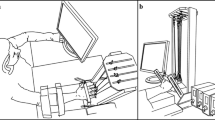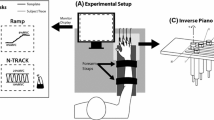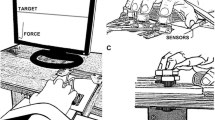Abstract.
Most common motor acts involve highly redundant effector systems. Understanding how such systems are controlled by the nervous system is a long-standing scientific challenge. Most proposals for solving this problem are based on the assumption that a particular solution, which optimizes additional constraints, is selected by the nervous system out of the many possible solutions. This study attempts to address this question in the context of coordinating individual finger forces to produce a controlled total force oscillation between 5% and 35% of each subject's maximum force of voluntary contraction, under two different combinations of four fingers. The structure of variability of individual finger forces was evaluated with respect to hypotheses that, at each instance in time, subjects attempt to: (1) stabilize the value of total force and (2) stabilize the total moment created by the fingers about the long axis passing through the forearm and midline of the hand. The results provide evidence that a range of goal-equivalent finger force combinations is generated to stabilize the values of total force and the total moment. The control of total force was specified explicitly by the task. However, it was stabilized only near the time of peak force. In contrast, the total moment was stabilized throughout most of the force cycle. The results lead to the suggestion that successful task performance is achieved, not by selecting a single optimal solution, but by discovering an appropriate control law that selectively stabilizes certain combinations of degrees of freedom relevant to the task while releasing from control other combinations.
Similar content being viewed by others
Author information
Authors and Affiliations
Additional information
Received: 2 February 2001 / Accepted in revised form: 21 June 2001
Rights and permissions
About this article
Cite this article
Scholz, J., Danion, F., Latash, M. et al. Understanding finger coordination through analysis of the structure of force variability. Biol Cybern 86, 29–39 (2002). https://doi.org/10.1007/s004220100279
Issue Date:
DOI: https://doi.org/10.1007/s004220100279




